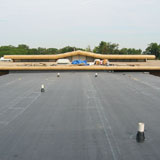Installing a roof system properly requires the constant diligence of roof system designers, roofing contractors, manufacturers and roof consultants. Sometimes, contractors and/or their crews make mistakes, and a roof system may not be installed as well as it should have been. But mistakes also happen during the roof system design phase.
Professional Roofing asked Mike Blanchette, vice president of Amtech Roofing Consultants Inc., Dallas; Dane Bradford, president of Bradford Roof Management, Billings, Mont.; Bruce McCrory, chief operating officer and general manager of Kiker Corp., Mobile, Ala.; and Thomas L. Smith, president of TLSmith Consulting Inc., Rockton, Ill., to describe the top 10 design mistakes they come across regularly. Following are their comments.
Mike Blanchette
Following are my top 10 design mistakes—in no particular order.
- Details that cannot be achieved. Often, I see wood blocking or other components hung on or attached to nothing. Other times, I find sheet-metal profiles that are just about impossible to form. In still other instances, I see details that are outdated or violate good roofing practices. During design review, I often remind design professionals they can't just show wood without an attachment or expect a sheet-metal mechanic to create their dream just because it can be drawn and put on paper.
- Lack of details. All designers are responsible for designing in a professional manner. If a client desires an apples-to-apples bid, the more detailing the better. A typical surface-mounted wall counterflashing should have corners and termination detailing in addition to a single-wall detail.
- Lack of FM Global knowledge. It always amazes me when I see roofing documents that call for FM 1-90 compliance but the specifications writer has no knowledge what that really means. Too many specifications writers still believe it relates to a 90-mph (145-km/h) wind-speed resistance. We all should know it relates to 45 pounds (20 kg) of uplift resistance times a safety factor of two. Furthermore, the need to have continuous wood blocking at the perimeter that conforms with insulation heights often goes without thought to specifics; a roofing contractor will have to taper and bevel his blocking at a wall with crickets or saddles.
- Allowing the use of untested products. Submittal review often finds products that are similar to those specified, but when they are viewed as part of a complete system, they just don't fit the requirements. As an example, not all polyisocyanurate insulation complies with an Underwriters Laboratories (UL) Inc.-tested roof assembly. Slope limitations also should be examined before approval of specific products.
- Asbestos-containing materials. I still see old ASTM International numbers in some roofing specifications that refer to mastics or felts with asbestos-containing products. There still are mastics, for example, made with asbestos that could be put in place on a new roof system, which may make an owner quite unhappy.
- Closed system specifications on a public bid project. I am sure this issue is high on all independent roof system designers' lists. As much as designers would like to limit competition, it is difficult to "lock in" a set of specifications when public money is at stake. I agree there are some products that no substitute can equal, but a designer better have all T's crossed and I's dotted when he specifies a single product in construction documents.
- Converse to my sixth concern is a set of specifications that basically has no limitations. Sometimes, I see construction documents that say nothing more than "put down a roof" with no regard to quality assurance, ASTM standards or other industry standards.
- Value engineering. This possibly is the worst phrase and practice ever decided upon in the construction industry. I think a better phrase would be "what do you not want in your building." With regard to roofing, is dropping from a four-ply system to a three-ply system really a benefit when considering roof system expectations over the long run? Also, it seems so much easier to "chop" from the roof system than to "chop" or cheapen the carpeting or wall finish. Why is this?
- Lack of code compliance. Just about everyone knows a 1/4-in-12 (1.2-degree) positive slope needs to be built into a low-slope roof system. Now, it's up to everyone to get up to speed on energy, plumbing, and other important life and safety issues.
- Lack of a good paper trail. I'm all for cutting down on unnecessary paper and correspondence. But I tend to find that memories are short. I often am called in after the fact to try and resolve a dispute or deficiency in a roofing-related project. If there is a good set of submittals, clear change orders and requests for information, and good close-out documents, problem resolution becomes much easier.
Dane Bradford
Following are my Top 10 design mistakes (in no particular order):
- Specifying a roof system simply because it worked on another building. This could be the most common mistake made by designers. All too often, I see specifications that simply are a reprint of the same specification a designer has used on the past 20 buildings he designed. A review of The NRCA Roofing and Waterproofing Manual, Fifth Edition, will indicate a thorough consideration of criteria such as a building's structural and architectural components, location, height and interior usage, among many others, plays a part in the development of a roof system specification that will provide satisfactory performance. The reality is that there is no such thing as a panacea in the roofing industry.
- Designing a roof drainage system that does not recognize water runs downhill. In virtually every case, a roof system will perform better when it does not pond water. The most common situation when ponded water occurs is when a structure is sloped and the low point of a roof deck rests on structural members. In most cases, this will not allow for drains to be installed at the low point of a roof deck. Even a minimal offset of drains can become a nightmare of ponded water, pointed fingers and unhappy customers. By keeping in mind from the outset that water runs downhill, designers and contractors can make appropriate decisions concerning drainage before construction begins.
- Not designing a roof system and related details with future roof system replacement in mind. With few exceptions, roof systems need to be replaced at some point during buildings' lives. During initial design and detailing, consideration should be made as to the installed heights of penetration curbs; access doors; conduit lines and gas lines; heating, ventilating and air-conditioning units; and counterflashings, cap flashings and through-wall flashings. These considerations can make the difference between a relatively low-cost reroofing project and one that involves needless and expensive disconnection and reconnection of units and duct work, rebuilding or extending existing curbs, and involvement of cranes or other equipment to lift units that will not allow for additional insulation or system changes during a reroofing project.
- Using UL and FM standards as a catch-all without understanding them or their effects. As valid as a UL Class A or an FM 1-90 rating may be, they have, in many designers' specifications, become default standards that often have little or nothing to do with satisfactory performance of a chosen roof system. Certainly, the ease of understanding the supporting information for these standards can be difficult, but thoroughly understanding them is essential to overall system performance, as well as code conformance and cost effectiveness of a finished roof system.
- Specifying insulation based on unrealistic R-values. The ongoing discrepancies in accepted R-values between those published by insulation manufacturers and those accepted by groups such as NRCA have posed difficulties for designers for years. The term "design mistake" may put too much onus on the designer in this situation. The continuing disagreement about what should be an acceptable aged R-value for polyisocyanurate insulation results in confusion of designers, frustration of roofing contractors and potential energy inefficiencies in mechanical system designs that are not only costly to the owner but potentially can lead to legal difficulties for designers and contractors.
- Specifying roof systems that do not meet local building code requirements. Most designers are quite conscious of the fact that building codes need to be followed and try hard to follow these requirements. However, the disconnect that often occurs is in translating specific code requirements to a specific roof system and the related standards the codes reference or require. In short, this adds one more layer of confusion to the already confusing situation described in my fourth concern. Add to this the innumerable permutations of codes that can occur in a municipality or state where a designer performs work, and you can see the potential for mistakes to be made.
- Specifying a roof system based solely on a manufacturer's warranty. Designers, owners and roofing contractors need to remember manufacturer warranties are, for the most part, a list of exclusions that limit a manufacturer's liability in case of a claim. To specify a roof system simply based on a 10-, 15- or 20-year warranty ignores this reality. Designers need to remember a piece of paper does not keep water out of buildings. (See my 10th concern.)
- Specifying the "newest" material on the market. The innovation that the manufacturing community shows year after year in developing new systems and accessories is admirable and is what makes U.S. business great. However, in most cases, a successfully performing roof system often exists as a result of trial and error. Most people would have a difficult time identifying a successful material or system that hasn't been changed or improved in some way as a result of in-place performance issues. Unfortunately, in a few cases, products or systems are introduced and marketed to designers who have a penchant for specifying the "newest" thing on the market. Although this is not necessarily a wrong approach, it certainly increases the potential for problems and liability.
- Not requiring cover boards over polyisocyanurate insulation. For at least the past 20 years, NRCA has recommended the use of cover boards over foamed plastic insulation to prevent a myriad of potential problems and improve overall roof system performance. The evidence—anecdotal and empirical—continues to prove these recommendations are valid. From a technical and practical standpoint, the benefits continue to far outweigh the marginally higher installed cost that will result from inclusion of a proper cover board.
- Not requiring an ongoing maintenance program as part of specifications. Conventional wisdom has been that three things are needed to make a roof system perform well: good design, good materials and good workmanship. However, all roofing industry segments recently have realized that though each of these is important to achieve long-term roof system performance, one thing is missing—maintenance. The one group that has failed in many cases to embrace this concept is the design community because of the overreliance on manufacturer warranties and misunderstanding of what they cover. Roof system designers need to understand that virtually all warranties specifically limit coverage in case a building owner does not perform regular maintenance on a roof system. Provisions for maintenance services need to be made in specifications during initial design of a roof system.
Bruce McCrory
We mainly contract for reroofing jobs, so usually we are the prime contractor and have a lot of input with designers.
The following 10 roof system design mistakes came to my mind first. These 10 are not necessarily in order of aggravation!
- Failure to prequalify contractors. Contractors should be prequalified. Too many designers allow any and all contractors to bid whether or not they are qualified.
- Failure to adequately inform a building owner about a project's scope and magnitude. This especially is noticed in reroofing projects. A building owner has a responsibility to the project, and the designer should take adequate steps to inform and educate the owner during all phases of a project.
- Failure to consider the scope and magnitude of unusual existing conditions. Many designers will note unusual conditions but fail to take in the magnitude of addressing such conditions.
- Wrong selection of systems and/or components. Some designers do not have the proper skills and qualifications to make product selections that are proper for a project or site conditions.
- Improper tapered system and tapered system design. We see this in reroofing projects when a designer does not adequately understand tapered systems and the need for correct positive drainage.
- Inadequate fastening design of insulation or system attachment. This occurs when a designer chooses wrong fastening methods or has no information about fastening methods.
- Inadequate flashing details. Sometimes, a designer chooses wrong flashing details or has incorrect or no information about flashing details.
- Inadequate drainage considerations for gutters, downspouts, overflows and ground water management.
- Conflicts between specifications and details. This is kind of a catch-all, but it still continues to be an area of inadequate design.
- Inadequate consideration of warranty and maintenance of the system after installation. This is another area where education of the owner should be better.
Tom Smith
Following are 10 common design mistakes that result in or significantly contribute to premature problems. There are other common design mistakes, such as not complying with building codes, but those don't necessarily result in problems. I've limited my comments to mistakes that often result in problems.
- Failure to adequately correct problems with the existing roof assembly. Common examples of this are failure to identify and specify the removal of wet insulation and/or deteriorated components (such as roof deck and wood nailers); failure to specify reattachment or additional attachment of poorly attached roof deck or wood nailers; and failure to specify the relocation of existing rooftop penetrations that are too close together or too close to a parapet to allow a roof mechanic to adequately flash the penetrations. Another example is the failure to evaluate the uplift resistance of an existing roof assembly before adhering a new roof covering when attachment of the new covering depends on the adequacy of the existing attachment.
- Failure to specify design enhancements when conditions are extreme. Standard details and roof assembly configurations and materials typically offer satisfactory performance when a roof is exposed to "normal" conditions. However, when a building is located in an area with extreme weather conditions or subjected to unusual events, design enhancements are needed to avoid premature problems. For example, if icicles can drop from an upper roof onto a lower one, special measures (such as concrete pavers) often are needed to avoid damage.
- Failure to specify wind-uplift attachment requirements for mechanically attached parapet base flashings and attachment requirements (including zone delineation on the roof plan) at the roof perimeter and corners.
- Failure to adequately specify and detail flashings. Common examples of this include base flashings with inadequate height; lack of secondary flashing (such as membrane material) underneath copings; expansion-joint curbs detailed without slope (which permits water to stand on top of the curb); and when pitch pockets are necessary, inadequate attention to their design and inadequate specification of filler materials and their installation.
- Failure to alert building owners about the need for periodic inspection, maintenance and repairs. A lack of timely inspection, maintenance and repairs often results in increased maintenance/repair costs and/or decreased service life of a roof system.
- Failure to adequately support rooftop equipment. Common examples of this are inadequate attachment to resist wind or seismic loads and inadequate clearance between equipment and a roof's surface (which thereby inhibits proper installation of a roof membrane and curb/stand flashings).
- Failure to coordinate a roof system with a roof structure with regard to mechanically attached single-ply systems over steel decks. Related problems include lack of specification regarding membrane fastener row orientation with respect to deck flanges (rows typically should run perpendicular to the flanges); lack of specification of FM-approved decks when an FM-approved roof system is specified; and in the case of high wind-uplift loads, lack of specification of deck grade and deck attachment criteria (based on assembly testing).
- Failure to coordinate, design and specify attachment of a lightning protection system to a roof surface. Ramifications of inadequate attachment include conductor (cable) abrasion of a roof surface and detachment of the conductor connectors from the roof surface or detachment of the conductors from the connectors, which can result in roof membrane punctures or tears.
- Failure to calculate snow loads and specify guards with adequate strength. When inadequate design attention is given to snow guards, snow depth well below design conditions can shear guards off a roof.
- Lack of regard for aesthetics. When specifying white roof surfaces on visible roofs (such as domes), inadequate attention to aesthetics sometimes results in an objectionable appearance caused by dirt accumulation or biological growth on a roof surface. When aesthetics are important, careful selection of a white membrane or coating is essential. Some roofing materials are more susceptible to dirt and/or biological growth than others.
A chance for discussion
The design mistakes mentioned in this article are not the only reasons roof systems fail, but they should be considered. This month, NRCA and the Roof Consultants Institute (RCI) published a consensus document, NRCA/RCI Roofing Project Submittal and Protocol Guidelines, to assist contractors, designers and building owners in the roof system application process so the mistakes mentioned are minimized.
The publication is available by contacting NRCA InfoExpress at (866) ASK-NRCA (275-6722) or accessing shop.nrca.net.
Ambika Puniani is editor of Professional Roofing magazine and NRCA's director of communications.



